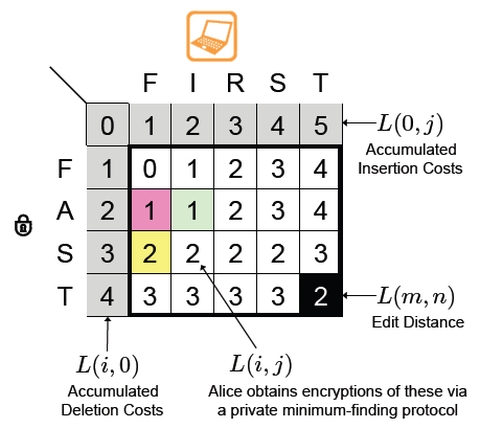TR2013-004
Privacy-Preserving Nearest Neighbor Methods: Comparing Signals without Revealing Them
-
- , "Privacy-Preserving Nearest Neighbor Methods: Comparing Signals without Revealing Them", IEEE Signal Processing Magazine, DOI: 10.1109/MSP.2012.2230221, Vol. 30, No. 2, pp. 18-28, March 2013.BibTeX TR2013-004 PDF
- @article{Rane2013feb,
- author = {Rane, S. and Boufounos, P.T.},
- title = {{Privacy-Preserving Nearest Neighbor Methods: Comparing Signals without Revealing Them}},
- journal = {IEEE Signal Processing Magazine},
- year = 2013,
- volume = 30,
- number = 2,
- pages = {18--28},
- month = feb,
- doi = {10.1109/MSP.2012.2230221},
- issn = {1053-5888},
- url = {https://www.merl.com/publications/TR2013-004}
- }
- , "Privacy-Preserving Nearest Neighbor Methods: Comparing Signals without Revealing Them", IEEE Signal Processing Magazine, DOI: 10.1109/MSP.2012.2230221, Vol. 30, No. 2, pp. 18-28, March 2013.
-
MERL Contact:
-
Research Area:
Information Security

Abstract:
Comparing two signals is one of the most essential and prevalent tasks in signal processing. A large number of applications fundamentally rely on determining the answers to the following two questions: (1) How should two signals be compared? (2) Given a set of signals and a query signal, which signals are the nearest neighbors of the query signal, i.e., which signals in the database are most similar to the query signal?
Related News & Events
-
NEWS IEEE Signal Processing Magazine: 2 publications by Petros T. Boufounos and Shantanu D. Rane Date: February 13, 2013
Where: IEEE Signal Processing Magazine
MERL Contact: Petros T. BoufounosBrief- The articles "Privacy-Preserving Nearest Neighbor Methods: Comparing Signals without Revealing Them" by Rane, S. and Boufounos, P.T. and "Privacy-preserving Speech Processing: Cryptographic and String-Matching Frameworks Show Promise" by Pathak, M.A., Raj, B., Rane, S. and Samaragdis, P. were published in IEEE Signal Processing Magazine.
